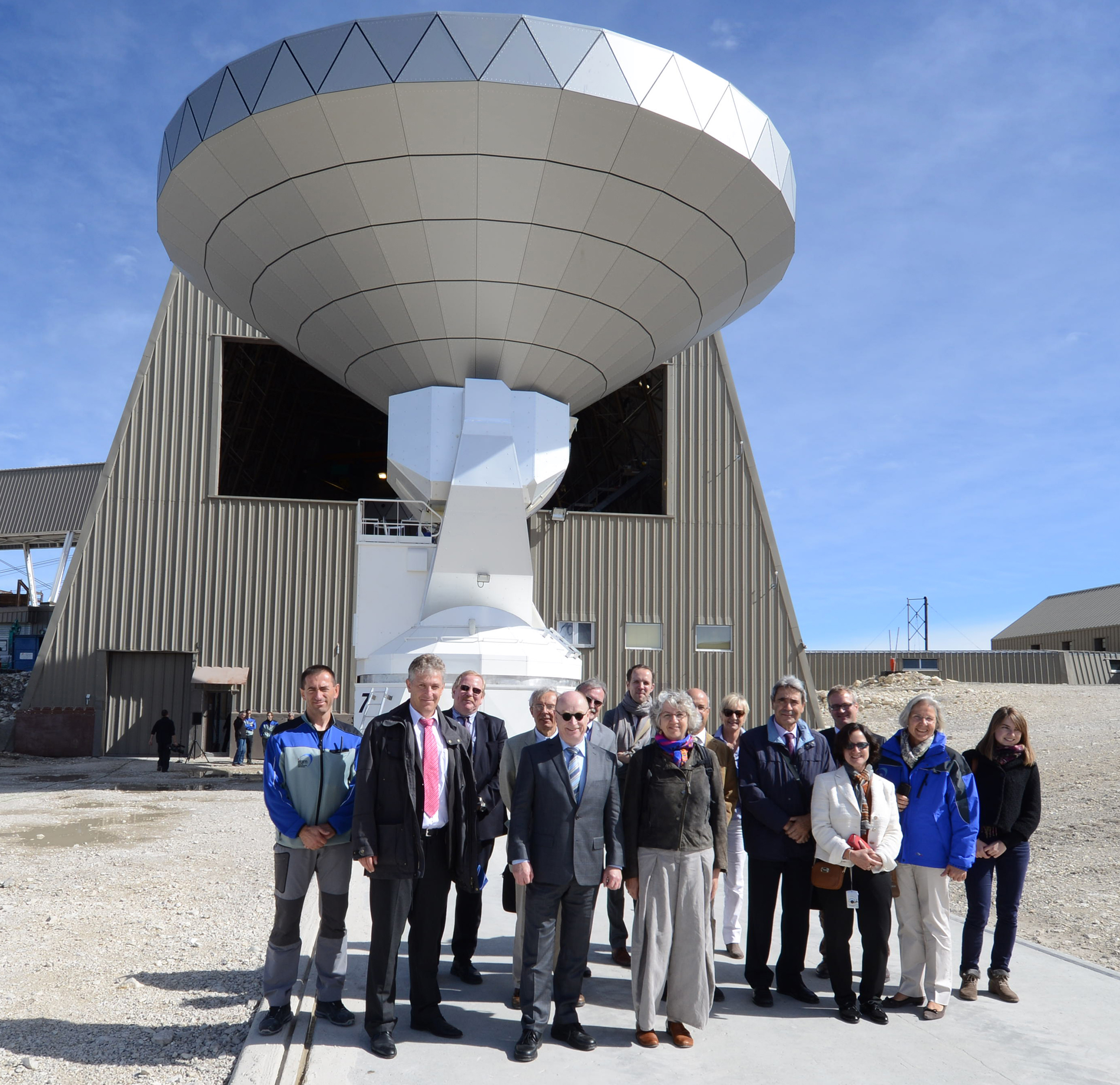News
First step for NOEMA: MPG President, INSU Director and German Ambassadress inaugurate 1st antenna!
NOEMA in the search for our origins
The observatory on the Plateau de Bure is being expanded to become the most powerful radio telescope in the northern hemisphere
With the official inauguration of the first of six planned NOEMA antennas on 22 September, IRAM is taking a crucial step towards one of the largest Franco-German projects in astronomy: the expansion of the Plateau de Bure observatory in the French Alps into the most powerful and most sensitive millimetre radio telescope in the northern hemisphere. The scientists are hoping that this state of the art observatory will provide answers to questions about our origins and the formation of the universe.
 |
|
Official inauguration of the 1st NOEMA antenna (from left to right): Bertrand Gautier (PdB station manager), Karl Schuster (IRAM Director), Reinhard Genzel (MPE Director), Richard Bonneville (French Ministry for Research), Martin Stratmann (MPG President), Klaus Ranner (Consul General of the Federal Republic of Germany), David Musial (German Ambassy), Pascale Delecluse (INSU Director), Denis Mourard (INSU Vice Director), Brigitte Indigo (IRAM), Jesus Gomez-Gonzalez (Vice Director Spanish IGN), Markus Schleier (MPG), Linda Tacconi (IRAM SAC Member), Susanne Wasum-Rainer (Ambassadress of the Federal Republic of Germany), Milda Krasauskaite (MPG). © Edyta Tolwinska |
Millimetre wave radio astronomy plays a key role in modern astrophysics. While optical telescopes are geared mainly towards the observation of hot celestial objects, such as stars, these radio telescopes allow researchers to investigate the cold universe at temperatures only a few degrees above absolute zero (-273.15 degrees Celsius). They can find objects which optical instruments cannot observe, because the former are surrounded by cosmic dust and interstellar clouds.
The researchers are thus able to push on towards the most distant galaxies and analyse black holes at the edge of the universe we know. At the same time, radio astronomy makes it possible to analyse interstellar molecules and cosmic dust itself – key elements in the formation of stars and galaxies and thus for the evolution of the cosmos.
NOEMA (NOrthern Extended Millimeter Array) is one of a new generation of radio telescopes and will be the most powerful interferometer in the northern hemisphere when it is completed. “The Plateau de Bure observatory is already one of the best and most sensitive radio telescopes in the world, but NOEMA will make us part of a new era of radio astronomy,” says Roberto Neri, IRAM researcher and scientific director of the array on the Plateau de Bure.
Thanks to six additional 15-metre antennas and the use of completely new instruments, as well as an extension of the track systems, which allow the telescopes to be positioned at separations of up to 1.6 kilometres, NOEMA will measure the sky with ten times the sensitivity and four times the spatial resolution that was possible with the previous instruments. The observatory is located on a unique plateau in the French Alps at an altitude of more than 2500 metres above sea level.
The new, high-sensitivity receiver systems, which use extremely high frequency and terahertz technology, as well as superconducting detectors and cryogenic technology, are being developed at IRAM in the Institute’s own laboratories.
The radio observatory, with its twelve antennas, will be operating according to a principle known as imaging interferometry. To this end, the researchers direct all the individual antennas together towards one astronomical object and then superimpose the signals they receive. Using this superposition and mathematical methods, an image is obtained with the spatial resolution of a much larger telescope whose diameter corresponds to the distance between the dishes – in the case of NOEMA, a telescope with a diameter of up to 1600 metres.
“NOEMA’s spatial resolution of 0.2 arc seconds* corresponds to that of the VLT, the largest telescopes of the European Southern Observatory ESO, and thus complements its observations particularly well.” (*0.2 arc seconds corresponds approximately to one ten thousandth of the angle at which the full moon appears)
NOEMA will allow the astronomers to obtain precise images of interstellar gas clouds and the star births which take place therein.
At the same time, the scientists hope for answers to the most fundamental questions of modern astronomy: How did the first generation of stars form immediately after the Big Bang? How did the first large structures in the universe evolve to eventually form galaxies such as our Milky Way? What exactly drives the cosmic cycle of interstellar matter, which stars eject into space at the end of their life and from which new suns form? And how do planets and planetary systems form?
Ultimately, NOEMA will become an extremely important part of an even larger global interferometer, which scientists from Europe and the United States will use to investigate the nature of the super-massive black holes in the centre of our Milky Way and other nearby galaxies in the years to come.
NOEMA, with a planned total budget of 45 million euros, is operated and funded jointly by the institutions which founded IRAM: the Max Planck Society and the Centre National de la Recherche Scientifique. Next year will already see the installation of the second of the six new antennas. It is expected to take another four to five years before it is complete with all twelve antennas.
IRAM Director, Karl-Friedrich Schuster, is enthusiastic: “Together with the advancing technological developments, this telescope opens up completely new possibilities to investigate the fascinating questions of modern astronomy.” At the same time, the project is also the ideal partner for the ALMA radio telescope located in the southern hemisphere. “I am sure that NOEMA will perform important pioneering work in astrophysics above and beyond the decades to come,” says Schuster.
Click here for the French CNRS national press release
Click here for the German Max-Planck press release
Contact Presse:
Karin Zacher (IRAM press officer)



